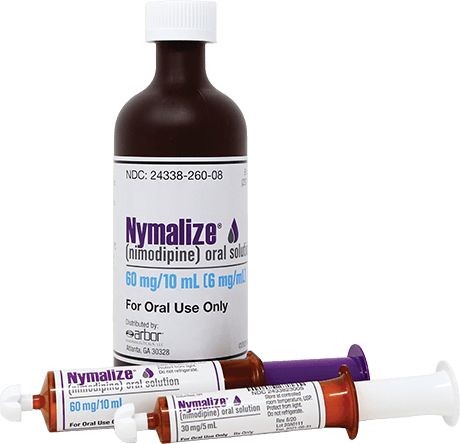
nimodipine – oral, Nymalize
Warning
Medication Uses
How To Use
Side Effects
Precautions
Drug Interactions
Overdose
Notes
Missed Dose
Storage
WARNING: This medication should not be given by injection. Accidental injection of nimodipine can cause serious side effects such as low blood pressure or slow heartbeat. Consult your doctor or pharmacist for details. USES: Nimodipine is used to decrease problems caused by bleeding in the brain (subarachnoid hemorrhage-SAH). Nimodipine is a calcium channel blocker that relaxes narrowed blood vessels near the area of bleeding, allowing blood to flow more easily and reducing brain damage. This medication may also be used to decrease problems due to stroke. HOW TO USE: See the Warning section. Read the Patient Information Leaflet before starting nimodipine and each time you get a refill. Take nimodipine as soon as possible after the start of bleeding in the brain, usually within 4 days. Take nimodipine every 4 hours or as directed by your doctor. If you are taking the tablet form, take it with a full glass of water and do not lie down for 10 minutes after taking it. If you are taking the capsule form, take it at least 1 hour before and 2 hours after meals. Swallow the capsule whole or draw the liquid out with a syringe and give it by mouth or through a nasogastric tube. Do not mix the capsule contents with other liquids. Do not take antacids within 2 hours of taking nimodipine tablets. Avoid grapefruit or grapefruit juice while using this medication. SIDE EFFECTS: Dizziness, lightheadedness, flushing, or swelling ankles/feet may occur. If these effects persist or worsen, tell your doctor or pharmacist. Seek medical attention immediately if you experience fainting, slow/fast heartbeat, severe abdominal pain, stomach bloating, inability to have a bowel movement for more than 3 days, severe nausea/vomiting, vision changes, rash, itching/swelling, severe dizziness, or trouble breathing. Consult your doctor or pharmacist for a complete list of possible side effects. PRECAUTIONS: Inform your doctor or pharmacist if you are allergic to nimodipine or other calcium channel blockers, or if you have any other allergies. Tell them about your medical history, especially chest pain/recent heart attack, low blood pressure, recent head injury, or liver disease. Do not drive, use machinery, or perform activities that require alertness until you are sure you can do so safely. Before having surgery, inform your doctor or dentist about all the products you use. This medication may cause dizziness, particularly in older adults. Avoid falling by getting up slowly from sitting or lying positions. During pregnancy, use nimodipine only when clearly needed and consult your doctor before breastfeeding. DRUG INTERACTIONS: Ask your doctor or pharmacist before using nimodipine with any other prescription or nonprescription medication. In particular, inform them if you are taking drugs for high blood pressure, other calcium channel blockers, cimetidine, azole antifungals, macrolide antibiotics, rifamycins, St. John’s wort, or drugs used to treat seizures. Check the labels on all your medicines, including cough-and-cold products and pain/fever drugs, as they may contain ingredients that could increase your blood pressure or heart rate. Cimetidine, commonly used to treat extra stomach acid, may interact with nimodipine.
QUESTION
If overdose is suspected, contact a poison control center or emergency room immediately. Laboratory and/or medical tests may be performed periodically to monitor your progress or check for side effects. If you miss a dose, take it as soon as you remember. Store nimodipine at room temperature away from light and moisture. Do not flush medications down the toilet or pour them into drains. Safely discard this product when it is expired or no longer needed. Consult your pharmacist or local waste disposal company for more details.


